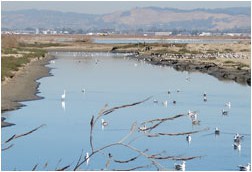Alameda Creek Sediment Removal
Home » Get Involved » Neighborhood Zones » Zone 5 » Alameda Creek Watershed & Fish Ladder » Alameda Creek Sediment Removal
The Alameda Creek Watershed is the largest watershed that drains to San Francisco Bay. At almost 700 square miles, it can generate an enormous amount of stormwater runoff and sediment—particles of sand, dirt, and other material.In the early 1970s, the Army Corps of Engineers constructed the Alameda Creek Federal Flood Control Channel to protect properties in Hayward, Union City, Newark, and Fremont from flooding. In doing so, the channel has been confined between levees that have altered sediment transport.Today, the lower (downstream) seven miles of Alameda Creek experience significant sediment accumulation. The lowest four miles (starting from the bay) are tidally influenced, and the sediment is probably of tidal origin. The next three miles (upstream of the lowest four miles) accumulate sediment from the upper watershed. This three-mile section has been dredged to remove silt—known as desilting—several times since the channel was constructed. Desilting is very expensive.

